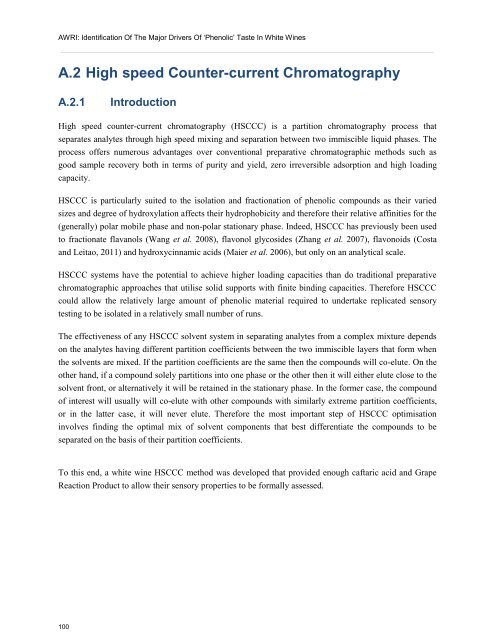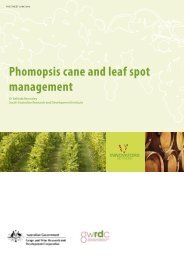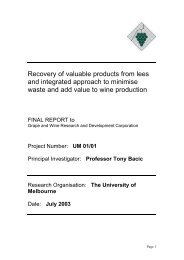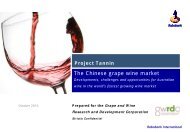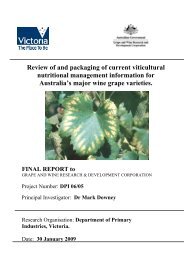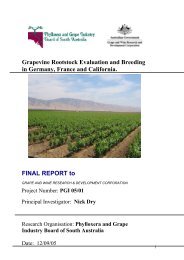Identification of the major drivers of 'phenolic' taste in ... - GWRDC
Identification of the major drivers of 'phenolic' taste in ... - GWRDC
Identification of the major drivers of 'phenolic' taste in ... - GWRDC
You also want an ePaper? Increase the reach of your titles
YUMPU automatically turns print PDFs into web optimized ePapers that Google loves.
AWRI: <strong>Identification</strong> Of The Major Drivers Of ‘Phenolic’ Taste In White W<strong>in</strong>es<br />
A.2 High speed Counter-current Chromatography<br />
A.2.1 Introduction<br />
High speed counter-current chromatography (HSCCC) is a partition chromatography process that<br />
separates analytes through high speed mix<strong>in</strong>g and separation between two immiscible liquid phases. The<br />
process <strong>of</strong>fers numerous advantages over conventional preparative chromatographic methods such as<br />
good sample recovery both <strong>in</strong> terms <strong>of</strong> purity and yield, zero irreversible adsorption and high load<strong>in</strong>g<br />
capacity.<br />
HSCCC is particularly suited to <strong>the</strong> isolation and fractionation <strong>of</strong> phenolic compounds as <strong>the</strong>ir varied<br />
sizes and degree <strong>of</strong> hydroxylation affects <strong>the</strong>ir hydrophobicity and <strong>the</strong>refore <strong>the</strong>ir relative aff<strong>in</strong>ities for <strong>the</strong><br />
(generally) polar mobile phase and non-polar stationary phase. Indeed, HSCCC has previously been used<br />
to fractionate flavanols (Wang et al. 2008), flavonol glycosides (Zhang et al. 2007), flavonoids (Costa<br />
and Leitao, 2011) and hydroxyc<strong>in</strong>namic acids (Maier et al. 2006), but only on an analytical scale.<br />
HSCCC systems have <strong>the</strong> potential to achieve higher load<strong>in</strong>g capacities than do traditional preparative<br />
chromatographic approaches that utilise solid supports with f<strong>in</strong>ite b<strong>in</strong>d<strong>in</strong>g capacities. Therefore HSCCC<br />
could allow <strong>the</strong> relatively large amount <strong>of</strong> phenolic material required to undertake replicated sensory<br />
test<strong>in</strong>g to be isolated <strong>in</strong> a relatively small number <strong>of</strong> runs.<br />
The effectiveness <strong>of</strong> any HSCCC solvent system <strong>in</strong> separat<strong>in</strong>g analytes from a complex mixture depends<br />
on <strong>the</strong> analytes hav<strong>in</strong>g different partition coefficients between <strong>the</strong> two immiscible layers that form when<br />
<strong>the</strong> solvents are mixed. If <strong>the</strong> partition coefficients are <strong>the</strong> same <strong>the</strong>n <strong>the</strong> compounds will co-elute. On <strong>the</strong><br />
o<strong>the</strong>r hand, if a compound solely partitions <strong>in</strong>to one phase or <strong>the</strong> o<strong>the</strong>r <strong>the</strong>n it will ei<strong>the</strong>r elute close to <strong>the</strong><br />
solvent front, or alternatively it will be reta<strong>in</strong>ed <strong>in</strong> <strong>the</strong> stationary phase. In <strong>the</strong> former case, <strong>the</strong> compound<br />
<strong>of</strong> <strong>in</strong>terest will usually will co-elute with o<strong>the</strong>r compounds with similarly extreme partition coefficients,<br />
or <strong>in</strong> <strong>the</strong> latter case, it will never elute. Therefore <strong>the</strong> most important step <strong>of</strong> HSCCC optimisation<br />
<strong>in</strong>volves f<strong>in</strong>d<strong>in</strong>g <strong>the</strong> optimal mix <strong>of</strong> solvent components that best differentiate <strong>the</strong> compounds to be<br />
separated on <strong>the</strong> basis <strong>of</strong> <strong>the</strong>ir partition coefficients.<br />
To this end, a white w<strong>in</strong>e HSCCC method was developed that provided enough caftaric acid and Grape<br />
Reaction Product to allow <strong>the</strong>ir sensory properties to be formally assessed.<br />
100


